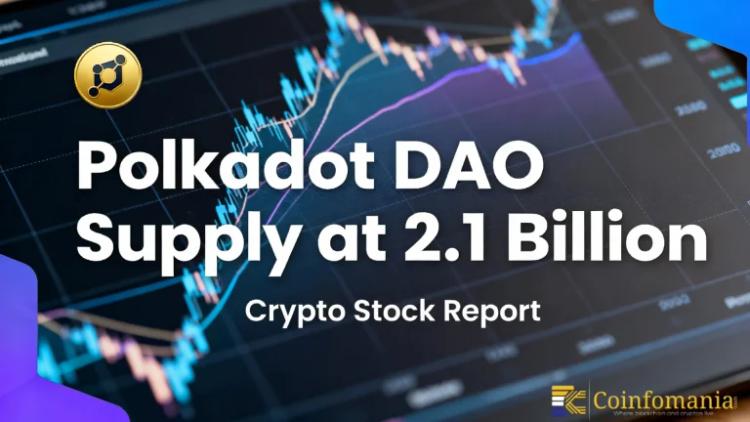DOT
As of December 29, 2025, Polkadot (DOT) is trading at approximately 3.83 USD, reflecting a -3.95% decrease from the previous close.
| Current Price | 24h Price Change | 7-Day Avg Price | Support Level | Next Resistance |
| $3.83 USD | -3.95% | $4.00 USD | $3.17 USD | $11.11 USD |
📈 Technical Analysis Summary
- Price Movement: The -3.95% decrease indicates Bearish pressure; potential uncertainty or profit-taking.
- 7-Day Average Comparison: Trading below the 7-day average ($4.00 USD); weak or consolidating trend; watch for support breakdown.
- Support and Resistance Levels: Price is above support ($3.17 USD); confirms bullish base. Room for growth before hitting resistance ($11.11 USD).
- RSI Analysis: RSI at 45.89 indicates Neutral zone; balanced market.
- MACD Analysis: Negative MACD (-0.06); suggests bearish momentum.
📊 Market Sentiment
| Indicator | Value | Interpretation |
|---|---|---|
| RSI | 45.89% | Neutral; neither overbought nor oversold |
| MACD | -0.06 | Bearish; suggests downward momentum |
| Above 7-Day Avg? | No | Indicates bearish pressure or cooling off |
| Above Support? | Yes | Suggests price stability above support. |
Polkadot Price Prediction Preview
| Forecast Range | Prediction Trend |
|---|---|
| Daily | 📉 Bearish — Caution in the short term due to weakening indicators |
| Weekly | 🔻 Weak — Risk of short-term pullback if support breaks |
| Monthly | 📉 Limited upside — DOTUSD needs stronger volume to break resistance |
| Yearly | 🧯 Uncertain — Macro factors may limit long-term upside for DOTUSD |
Related News

Polkadot DAO Caps DOT Supply at 2.1 Billion
The Polkadot DAO has carried out its most notable economic change up till now. On October 18, 2025, the account of Polkadot announced a plan to limit the total supply of DOT to 2.1 billion, and to halve the further emission after every 2 years, starting March 14, 2026. This giant turnover is the reflection […]
Triparna Baishnab
Author

Polkadot Confirms Smooth Asset Hub Migration — 1.63B DOT and 1.5M Accounts Shifted Without Downtime
Triparna Baishnab
Author

Hong Kong Welcomes Polkadot in Fifth Batch of Strategic Enterprises
Shweta Chakrawarty
Author

ZeroHash Expands Blockchain Ecosystem with Full Polkadot Integration for Seamless Cross-Chain Transactions
Triparna Baishnab
Author

Polkadot Unveils DOT Director Initiative to Enable Legal Accountability and Transparent Execution of Community Proposals
Kanishka Bothra
Author
Launched in May 2020 behind Web3 Foundation and Ethereum co-founder Gavin Wood, Polkadot (DOT) is a Layer-0 blockchain protocol. They are built to interconnect with multiple blockchains, so that they can be used securely and scale efficiently. The Polkadot network runs on DOT to hold assets through staking and allows users to govern operations while providing secure chains for apps, DeFi services, NFT storage, and video games. In 2025, Polkadot continues its role as a top Web3 system creator with its mission of making multiple blockchain systems work together better.
How Does Polkadot Work?
Consensus, security and cross-chain communication is all handled by a central Relay chain, which then operates in a Polkadot network. The Relay Chain is an independent chain of blockchains called parachains that run your own applications. Parathreads are for a more flexible and temporary connectivity; smaller projects can use them, while the ones we mentioned above are for exporters in productive activities.
Nominated Proof-of-Stake (NPoS) is the network's consensus mechanism, which means that validators produce new blocks and nominators stake DOT to support trustworthy validators. Polkadot manages to keep decentralization and strong security while being capable of handling thousands of transactions per second, thanks to this system. Moreover, the interoperability is increasing even further as Bridges are developed to connect Polkadot to external networks, such as Ethereum and Bitcoin.
Polkadot and Other Cryptocurrencies
Ethereum, Cosmos, and Avalanche are the major competitors of Polkadot, however, they differ from the latter as they don’t offer cross-chain interoperability.
Uses smart contracts, but cannot achieve sufficient scale without layer-2 solutions and has less interoperability.
It has Cosmos’ interoperability vision, but its independent chain model is different from Polkadot’s shared security system.
Provides high speed, but it doesn’t matter as it automatically integrates with the blockchain and the governance process.
With a model of NPoS, Polkadot is an energy-efficient model that will consume much less power when compared to Bitcoin’s Proof of Work mechanism, which is in line with the current standard in the environment.
Technology Behind Polkadot
The core innovations of Polkadot are built up into several core innovations:
- Parachains: Relies on a platform called the Relay Chain that sustains network consensus and connects the parachains to each other.
- Specialised, independent blockchains that are optimized for different types of tasks and for different types of applications.
- Bridges allow Polkadot to be connected to other blockchains for cross-network transactions to occur.
- A staking model that increases security and decentralisation, namely Nominated Proof-of-Stake (NPoS).
- A developer toolkit for easily and quickly building parachains.
Polkadot helps in scaling without compromising on the performance by supporting up to 100 parachains that will run parallel to each other.
Is Polkadot a Good Investment?
Like all cryptocurrencies, Polkadot presents good investment value yet remains subject to market dangers.
- DOT holds the 15th largest position in the cryptocurrency space with a price value of $7.20, performing in April 2025.
- Technology Strengths: It has interoperability and scalability that can serve as an attractive building block for future blockchain projects.
- Real-world use: Growth of DeFi, gaming, and NFT projects on Polkadot indicate expansion.
- Risks: High price volatility and regulatory uncertainty.
DOT is predicted to be around $10–$15 by 2025 and $25–$50 by 2030. The outcome depends specifically on the market and regulatory factors, including politics.
Legal and Regulatory Considerations in 2025
A tightening regulatory environment is also faced by Polkadot, as it is another major blockchain project.
The EU MiCA Regulation forces crypto platforms to follow standards in AML/KYC with a degree of transparency from January 2025.
For example, the Clarity for Payment Stablecoins Act is pending U.S. Regulations, which can affect the whole DeFi and Web3 ecosystem.
A more favourable US stance may relax some restrictions, which would benefit a decentralized project such as Polkadot.
New parachain launches and token offerings must also remain in compliance across jurisdictions, which means that Polkadot has to accommodate more than its strongest jurisdiction.
How to Buy and Trade Polkadot
Buying and trading DOT is straightforward:
- Choose an Exchange: Use reputable platforms like Binance, Coinbase, or Kraken.
- Sign Up: Create an account and complete KYC verification.
- Deposit Funds: Fund your account with fiat currency or another cryptocurrency.
- Purchase DOT: Use market or limit orders to buy.
- Store Securely: Transfer your DOT to a personal wallet after purchase for added security.
Traders can also use futures contracts or staking options available on major platforms for more advanced strategies.
Polkadot Wallets and Security
There are several types of wallets where DOT can be stored.
- Hardware Wallets: Devices like Ledger and Trezor offer offline storage for maximum security.
- Mobile applications like Polkadot.js or Fearless Wallet allow for easy access to your Software Wallet.
- Wallets: Convenient, but less secure for long-term holdings.
The choice of the wallet depends on how often you need to access your funds and how much security you need.
How to Secure Your Polkadot Holdings
To protect your DOT:
- Use Hardware Wallets to keep assets offline as much as possible.
- 2FA: Enable 2-factor authentication for exchange and wallet accounts to keep them secure.
- Patch vulnerabilities to prevent hacking risk and do regular software updates.
- Do NOT fall prey to Scams; Always verify the URLs, the emails and the wallet app you will be using to receive and send currency to avoid unnecessary problems.
- Store your backup information securely and offline with Backup Seed Phrases.
These practices are excellent at reducing the loss or theft risk.
Polkadot Adoption and Use Cases
Polkadot’s growing ecosystem includes:
- Lending, trading, and stablecoin projects like Acala and Moonbeam.
- Unique Network and RMRK are tools / NFTs marketplaces.
- Projects like Bit - The country provides decentralized gaming worlds.
- KILT Protocol is a developer of enterprise solutions which offer decentralised identity services.
- Polkadot extends its offerings to Ethereum and Bitcoin via Cross-Chain Bridges.
Nevertheless, these developments illustrate the flexibility and versatility of Polkadot for application in all kinds of fields.
Pros and Cons of Investing in Polkadot
Pros | Cons |
Connects multiple blockchains seamlessly | High market volatility |
Strong Web3 and DeFi ecosystem | Regulatory risks globally |
Energy-efficient NPoS consensus model | Competition from Cosmos, Avalanche |
Backed by Gavin Wood and Web3 Foundation | Technology complexity for new users |
Final Thoughts
One of the most innovative blockchain platforms is Polkadot (DOT) that aims to solve issues of interoperability, scalability and decentralisation. In terms of Web3’s future, it has Relay Chain, parachains, and strong developer activity. However, volatility and regulatory uncertainty in 2025 demand caution. Polkadot's success as the crypto market develops will hinge on keeping developer momentum, driving real-world use of the tokens and managing a more regulated environment.
Frequently Asked Questions
What is Polkadot (DOT)?
Polkadot represents a Layer-0 blockchain platform that Gavin Wood created in 2020, along with backing from the Web3 Foundation. Different blockchains known as parachains connect here to share safety and send value between networks. People use DOT tokens for both participating in network governance and securing the Polkadot platform.
How does Polkadot work?
Polkadot keeps a central Relay Chain secure as it connects many independent blockchains called parachains. Different stakers on Nominated Proof-of-Stake (NPoS) stake DOT to back up validators handling coin transactions. The system supports large-scale expansion and seamless network connection through bridges to Ethereum and Bitcoin platforms.
How does Polkadot differ from both Ethereum and Cosmos?
In contrast to Ethereum's single-chain hosting, Polkadot enables each optimised parachain to function best for specific needs and improve system efficiency. Like Cosmos, Polkadot uses interoperability features, but it offers greater shared security than Cosmos. Polkadot combines personalised setups while protecting against threats and connecting chains without problems.
What capabilities do Parachains provide for the network?
Parachains operate as separate protocols that connect to the Polkadot network simultaneously. Each customised blockchain survives safer thanks to Polkadot's base security and connects out to all platforms. The separate blockchain blocks within Polkadot help lower traffic amounts, so the network can process hundreds of thousands of transactions per second.
Will DOT make a strong financial return by 2025?
In cryptocurrency, DOT proves itself as a functional token for an advanced network platform. Different real-life uses in DeFi networks, online games, and identity systems are expanding the value of DOT. Investors need to monitor market fluctuations and new laws while watching for competition from Avalanche and Cosmos ecosystems.
Which method should I use to obtain and house Polkadot (DOT) tokens?
You can acquire DOT from platforms such as Binance, Coinbase, or Kraken using either cash or digital assets. Store your newly purchased DOT tokens by transferring them into a protected wallet such as Ledger or mobile platforms Polkadot.js and Fearless Wallet. Keep all your substantial funds away from exchange storage.
What specific applications help people use Polkadot in daily life?
Polkadot powers a diverse ecosystem. The project Acala focuses on decentralised finance, while Moonbeam creates Ethereum compatibility, and KILT Protocol handles decentralised identity platforms through Polkadot parachains. The platform enables NFT trading on RMRK and connects different blockchain games. Polkadot connects BTC and ETH networks so every blockchain user can benefit from its services.
Is Polkadot eco-friendly?
Yes. Polkadot chooses the Nominated Proof-of-Stake (NPoS) technology, which makes it much greener than Bitcoin's Proof-of-Work method. The use of minimal energy and the capability to process many transactions at speed make Polkadot suitable for blockchain sustainability goals.
Is Polkadot regulated?
The operations and token sales of Polkadot must follow government rules across multiple countries since it functions as a self-governed blockchain platform. Beginning in 2025, both the EU’s MiCA regulation and new U.S. payment stablecoins laws will influence blockchain system development nationwide. Although DOT receives no security classification, the laws around it keep changing.
What concerns should I think about when putting money into Polkadot?
Market instability creates major risks along with the unknown regulations of the sector and the project's complex engineering. Polkadot continues to lead in innovation but needs developers and users to adopt it, plus must handle parachain expansion problems and practical business partnerships. Researching multiple policies and spreading investments helps you avoid risks when entering the DOT market.